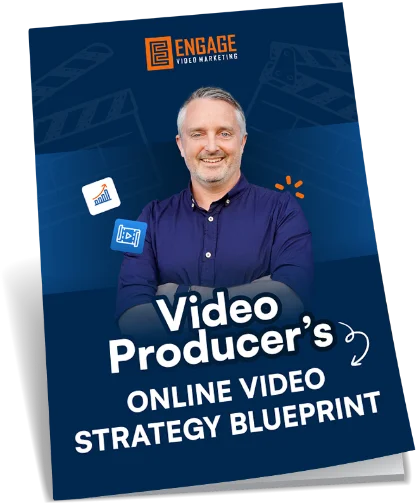“What gets measured, gets managed” – awesome quote, Peter Drucker! So when it comes to managing your video marketing strategy, what are you measuring to determine your success?
When it comes to your video marketing strategy, the amount of data, the metrics that are available to you can be pretty darn overwhelming. For many businesses using video to grow their reach and influence, they tend to focus on just a handful of metrics that seemed most obvious, for example, the number of views or subscribers or the likes – and that’s great! As Peter Drucker said, if you measure it, you can manage it.
However, this next quote, by the much quoted Albert Einstein sums it up even more when he said that “Not everything that can be counted counts and not everything that counts can be counted”. So, when you’re thinking about all the videos across your marketing strategy, is there a better data set to pay attention to? How can you decide on what metrics matter for any video in the first place. You see when it comes to the data that’s available around your online video strategy, the most important thing I want to share with you is to focus on the metrics that matter. Not everything that can be counted counts.
One of the huge benefits to digital marketing over traditional forms of marketing is the sheer amount of data that can be tracked – not to mention the depth of that data. It really can often be overwhelming as a marketer to dive into an analytics platform and see all the possible data that’s available to you.
To simplify things, I like to think of the available video metrics across all distribution channels in five main buckets of metrices:
1. Reach
2. Engagement
3. Conversion
4. Retention and;
5. Audience
Now whether Facebook or Snapchat, YouTube, or Instagram Stories, regardless of the platform, the metrics will fall into one of these five buckets. So let’s break down each one:
Reach Metrics
First up is reach metrics. Now this is the data that measures how many people have been potentially exposed to your content. Depending on the metric, this may determine that a video is simply being seen, but not played, or perhaps it’s auto played, but not really watched. Either way, though we can assume that there’s been a brand impression of some sort.
The main metric here that will be measured is “views”. It’s important to understand that not all platforms measure a view in the same way. For example, Facebook, Instagram, Twitter, LinkedIn, all say they report a video view in the same way, which is two continuous seconds, or at least 50% of the videos pixels that real estate of the video actually in view on the device.
YouTube on the other hand are less specific about what constitutes a view. YouTube reportedly use an algorithm to measure views in an attempt to filter out automated views and work to ensure that a view is actually a view. So as such, it’s widely considered that a view counts when about 30 seconds of the video has been watched. Other reach metrics that we may be tracking could be impressions, page traffic or email open rates. Determining return on investment or ROI for the reach bucket is typically measured in CPM or cost per 1000 impressions or cost per view or CPV. Now it’s important to recognise that in most cases, reach metrics really are just vanity metrics. The number might make you look good, but without engagement reach could be said to have little direct value for a business. So that said, and more valuable metric than reach is usually engagement.
Engagement Metrics
Engagement metric is the data that measures how interested your audience was in your content and how much of that content they actually engaged with. Now, obviously for most marketing, this metric is much more valuable to a business, as higher engagement is usually a direct link to greater effectiveness for your video to move people, to take the right action. The most important video metric to track for engagement is usually viewer retention or watch time – that is how long someone actually watched your video for. This is often measured in time or as an overall percentage of the video’s total length. Other engagement metrics that we might be tracking here could be likes, shares, and comments, session time or time on page or sound on views. Determining return on investment for engagement trends tends to be measured through cost per engagement or cost per click CPC.
Conversion Metrics
As you probably know, conversion is a measurement of when someone actually takes the desired action. So it will come as no surprise that conversion metrics are the numbers that often really make sense from a business perspective in business owners get excited about it. When a video strategy can directly lead to solid reportable conversion data, that return on video investment is in plain sight. The most common conversion metric that we tend to look at is then our sales that is dollars made through a transaction taking place. Now, alternatively, you may be measuring conversion such as new leads, lead quality conversion rate, traffic, or maybe click throughs. The return on investment for conversion is usually determined through CPA or cost per acquisition or cost per lead CPL.
Retention Metrics
You’re probably starting to see a trend here as the next metrics bucket to consider is based on retention or what happens with a customer after the sale is made. Retention metrics will be tracking things such as how long a customer stays a customer, how often they buy from you, how they rate the quality of your service and so on. The key metric that we’re looking at here is lifetime value or LTV, which is a measure of the total income, which will be generated by each customer on average. It’s a hugely valuable indicator of customer loyalty and advocacy when you can measure it right. Other retention metrics that may be tracked could be referrals or repeat purchase rate, customer churn, customer complaints, or through a net promoter score. Measuring return on investment for content with these metrics usually comes down to putting a dollar figure on lifetime value.
Audience Metrics
The final bucket of metrics is what I refer to as audience metrics. The data here is not so much directly related to the action that a viewer might take, but instead, these metrics are related to who the viewer actually is. So the value in tracking these metrics comes from developing an understanding of who’s actually engaging with your videos. Is this the right audience for your strategy? Are there unexpected
audiences engaging with your content that you can tap into in future videos?
Most platforms provide us with useful audience metrics and they can be loosely categorised according to demographics, such as geographical location, age, gender, playback locations, or playback device and discovery metrics such as traffic source. So when you’re designing an effective online video strategy for each video, you must be identifying which buckets of metrics you’ll need to be paying attention to – reach, engagement, conversion, retention, and audience.
Now, the big question is how do you determine which metrics matter for any given video in your strategy? Well, good question. I’m glad you asked. You, see the way you want to approach this is first be super clear on what the goal is for your video. What do you want someone to feel, think or do after watching your video? From there, you can work out which metrics, bucket or buckets to pay attention to. For example, if the goal for your video is to raise awareness of your brand, your product or your idea, then to be successful, you’ll be interested in getting the most interested eyeballs on your video, right? So in this case, you want to be focusing on the reach and engagement buckets. However, if the goal of your video is to directly move someone to make a purchase, then you’ll probably find more value in focusing on the conversion bucket and perhaps the retention bucket too. Ultimately when it comes to metrics as strategic video marketers, we’ll be looking for the data that reflects on a video’s effectiveness at driving a specific action.
Strategically what we’ll be doing is we’ll be looking back at the available data in our videos to work out what worked with each video, and then we’ll be using this data to plan forward for ideas to create future content that hopefully gets better results. For example, is the audience engaging with more videos featuring interviews, then let’s plan to make more of them. Does Google analytics data show more traffic to a sales page from Facebook than from Twitter? Then let’s focus your efforts more on Facebook then. Do the videos that are three minutes long result in a higher retention rate than the 15 minute videos? Well, then shorter videos are probably going to be best for your audience. I’ve simplified it, but hopefully you get the idea, pay attention to the metrics that matter. Be strategic with your video strategy and test measure, and refine from there.
But I’d love to hear from you – how do you measure the return on investment for your videos?





